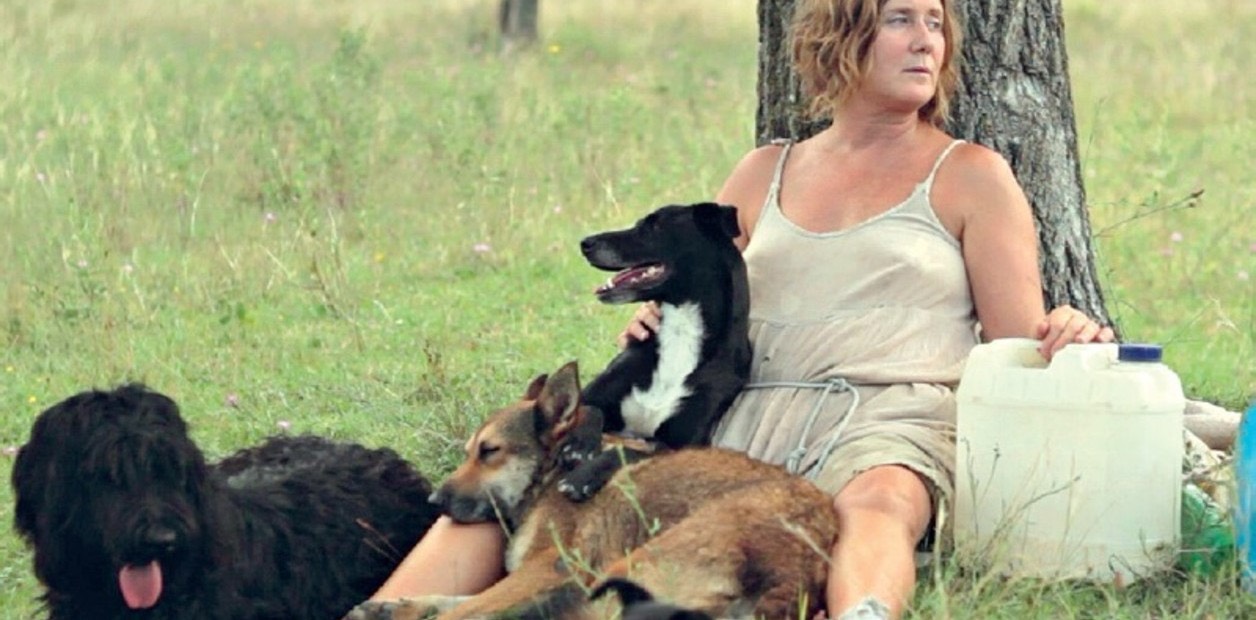Reframing Humans, Animals and Land in Contemporary Brazilian and Argentinian Cinema, Essay 5: Dog Lady, Companion Species Utopias in Dystopian Landscapes
May 18, 2019
Dana Khromov
The following is the third essay in the five-part series Reframing Humans, Animals and Land in Contemporary Brazilian and Argentinian Cinema. In it, Valeria Meiller, PhD Candidate in Spanish at Georgetown University, looks at how interspecies companionship and sustainable engagement with the environment are constrained by structures of oppression and marginality in La mujer de los perros (Laura Citarella and Verónica Llinás, Argentina 2015).
Dog Lady: Companion Species Utopias in Dystopian Landscapes

“How might an ethics and politics committed to the flourishing of significant otherness be learned from taking dog-human relationships seriously?” asks Donna Haraway at the beginning of the Companion Species Manifesto (2003: 3). The philosopher's inquiry opens up manifold possibilities for evaluating the presence of dogs as a companion species with whom we share “a story of co-habitation, co-evolution, and embodied cross-species sociality” (4). By foregrounding our relationships with dogs, Haraway highlights the relevance of human entanglements with animals as capable of providing a broader ethos for living in companionship. Her question, driven by the desire to push against the Western division of Nature and Culture, seeks to facilitate a mode of inhabiting Earth where different forms of life can flourish together; something that has become of uttermost importance as we settle into the Anthropocene and gain a deeper understanding of the scope of the current environmental crisis.
In the context of these questions, the Argentine film Dog Lady stands as a productive speculative space in which to situate Haraway’s reflections about dog-human relationships, and further understand the complexities that surround human-animal entanglements. This motion picture film by Laura Citarrella and Verónica Llinás (Pampero Cine, 2015) features a woman and a pack of dogs living together in the urban-rural fringe of Buenos Aires: a marginal, impoverished, and underdeveloped landscape where the woman and dogs lead a shared precarious life. But even in its dystopian landscape of poverty and homelessness, the film’s depiction of this small human-animal community offers productive cues to think about the dynamics of interspecies relationships, and how they could evolve towards less anthropocentric patterns of interaction. The relationship between the lady and the dogs, for instance, occurs completely unmediated by language. The Dog Lady is a middle-aged woman who neither speaks throughout the film nor is named at any point by others. She is just a woman surrounded by dogs and therefore she is simply the “Dog Lady” —or, as in the original Spanish title, “La mujer de los perros”, which ties her to the animals in a possessive bond that would literally translate as “the woman of the dogs.” The dogs also remain anonymous and unaddressed since the woman neither gives them a name nor speaks to them throughout the entire film, allowing them to live outside the constraining commands that would make the human into their master. By relating outside of language, the woman and the dogs are somehow freed from the bond of hierarchies: they do not enter into the nominations that would automatically rank them from an anthropocentric standpoint, and would center the human in a relationship of dominion.
This unarticulated companionship of dogs and woman pervades the whole ethos of the film, which is built through proposing a mode of relating to the environment that resembles that of composting; making the decayed into the fertile, waste into the usable, trash into infrastructure. In paradoxically adverse circumstances, the woman and the dogs embody an ecological ideal: their hut is wholly made out of recycled materials; they live outside the circulation of money and commodities; and they find the disposable reusable, reducing waste and resignifying objects that circulate outside of the market. The way the woman and the dogs insert themselves together into the work of “composting” opens up a productive space to think about the female role in ecological cooperation, and the way in which the film presents a feminist and ecological reflection that moves us beyond the perspective of precarity. Thinking about Dog Lady within these coordinates, the film situates women and animal solidarities as part of a shared struggle within the Nature-Culture divide that positions them both as oppressed subjects.
What is at stake is a historical tradition of oppression that affects both women and animals, but also unfolds as the potential of living in cooperative relationships with each other. I am by no means arguing for poverty as a viable mode of life, but am asking us to see the ways in which a feminist approach could make way for the possibility of living with nature and the nonhuman outside of relationships of domination. By looking through this dystopian urban-rural fringe, what the directors Citarella and Llinás offer is an opportunity to reflect upon less anthropocentric engagements with the environment. Rather than continuing to think only about the woman and the animal’s precarity, we might take this film as a provocation in another direction: towards thinking the coordinates of an ethos at the intersection of feminist and interspecies cooperation. For these collaborations to be successful, of course, they need to be reframed in conditions where both women and animals stop being excluded from the politics reserved to Culture in the Nature-Culture divide, and are resituated in a less binary framework that challenges their precarity by allowing the flourishing and safety of all forms of life.
Bibliography
Haraway, Donna. Companion Species Manifesto. United States of America: Prickly Paradigm
Press, 2003.
La mujer de los perros. Dir. Laura Citarella y Verónica Llinás. Pampero Cine, 2015. Film.
The full series here:
